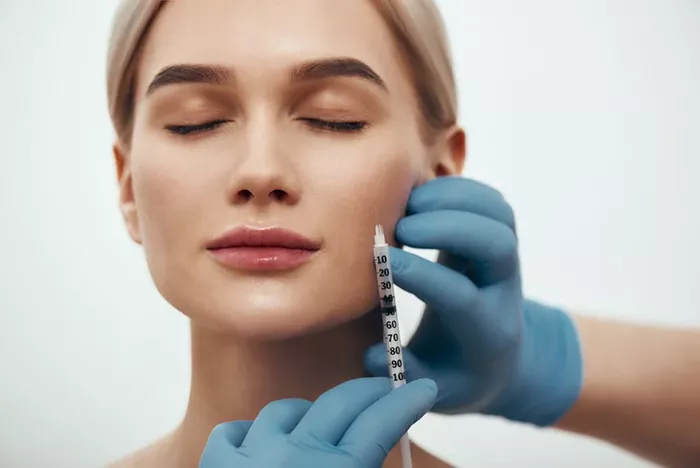Mid cheek lines are the small lines or folds that run from the lower eyelids toward the cheeks. They often become more noticeable with age. As we get older, our skin loses collagen and elasticity. This causes the cheeks to sag and creates hollow areas. These changes make mid cheek lines more visible.
They are also called “midface wrinkles” or “malar lines.” These lines can make the face look tired, sunken, or aged. Even if you feel energetic and happy, these lines may give the opposite impression.
What Causes Mid Cheek Lines?
Several factors contribute to the appearance of mid cheek lines:
- Aging: Skin loses its firmness and volume with time.
- Loss of fat: Natural fat pads in the face shrink or move with age.
- Sun exposure: UV rays break down collagen and speed up aging.
- Facial expressions: Repeated smiling or squinting can deepen lines.
- Lifestyle: Poor sleep, smoking, and stress can also affect the skin.
What Are Fillers?
Dermal fillers are gel-like substances injected into the skin to restore lost volume, smooth lines, and enhance facial contours. They are commonly made of hyaluronic acid, a substance naturally found in our skin. Fillers are widely used in medical aesthetics to rejuvenate the face without surgery.
Fillers for mid cheek lines help by lifting and plumping the skin. This reduces the appearance of hollow areas and smooths out the lines.
How Do Fillers Work for Mid Cheek Lines?
When injected into the mid cheek area, fillers add volume beneath the skin. This helps:
- Support the skin and tissue above.
- Restore natural contours.
- Smooth out the folds and fine lines.
- Create a youthful, refreshed look.
A skilled injector carefully places the filler in strategic areas of the cheek. This lifts the midface and reduces the depth of the lines. The results are usually instant and can last from several months to over a year.
Types of Fillers Used
There are different types of dermal fillers that can be used for mid cheek lines. The most common include:
1. Hyaluronic Acid (HA) Fillers
- Examples: Juvederm Voluma, Restylane Lyft, Teosyal Ultra Deep
- Benefits: Natural-looking results, reversible, hydrating
- Duration: 6 months to 2 years, depending on product
2. Calcium Hydroxylapatite (CaHA)
- Example: Radiesse
- Benefits: Stimulates collagen, longer-lasting
- Duration: Up to 18 months
3. Poly-L-lactic Acid (PLLA)
- Example: Sculptra
- Benefits: Encourages collagen production, gradual results
- Duration: Up to 2 years
Each filler has its strengths. The best choice depends on your skin, goals, and the recommendation of your injector.
Who Is a Good Candidate?
You may be a good candidate for mid cheek line fillers if:
- You notice lines or hollows in your midface.
- You want to look fresher without surgery.
- You are in good general health.
- You have realistic expectations.
A consultation with a qualified medical provider is essential. They will assess your skin and facial structure to create a custom treatment plan.
What to Expect During Treatment
Here is what typically happens during a filler session:
- Consultation: You discuss your concerns and goals with the provider.
- Assessment: The provider examines your face and may take photos.
- Cleansing: Your skin is cleaned and a numbing cream may be applied.
- Injection: The filler is injected with a small needle or cannula.
- Massage: The area is gently massaged to shape the filler.
- Aftercare: You get instructions for caring for your skin after treatment.
The entire process usually takes 30 to 60 minutes. You can go home the same day.
Recovery and Aftercare
There is minimal downtime after filler treatment. Some people may have:
- Mild swelling
- Redness
- Bruising
- Tenderness
These effects are normal and usually fade within a few days.
To help with healing:
- Avoid touching or rubbing the area.
- Skip intense exercise for 24 hours.
- Stay out of the sun and avoid alcohol.
- Use cold compresses if needed.
Your provider will give you specific aftercare tips based on your treatment.
How Long Do Results Last?
The results of mid cheek fillers can last from 6 months to 2 years. This depends on:
- The type of filler used
- How fast your body breaks it down
- Your lifestyle and skincare routine
To maintain the results, many people return for touch-ups once or twice a year.
Are There Any Risks?
Filler treatments are generally safe when done by experienced professionals. However, like any medical procedure, they carry some risks:
- Swelling or bruising
- Asymmetry
- Lumps or bumps
- Allergic reaction
- Rare complications like vascular occlusion
Always choose a licensed and experienced injector. This greatly reduces the risk of side effects.
Benefits of Mid Cheek Fillers
- Natural lift without surgery
- More youthful appearance
- Improved facial balance
- Fast treatment with little downtime
- Gradual or immediate results, depending on the filler
Things to Consider
Before deciding on fillers, think about the following:
- Cost: Fillers can be expensive, and multiple sessions may be needed.
- Maintenance: The results are not permanent and require upkeep.
- Injector skill: The outcome depends on the provider’s experience.
- Alternatives: Other treatments like microneedling or skin tightening may be better for some people.
Final Thoughts
Mid cheek line fillers offer a safe, effective, and non-surgical way to refresh your appearance. With the right provider and product, you can achieve natural, long-lasting results.
If you’re noticing tired-looking cheeks or deeper lines in your midface, it may be worth exploring this option. A good consultation will help you understand what’s best for your face, goals, and budget.
Always choose a qualified medical aesthetic professional for the best and safest results.
Related topics:
How Can I Reduce My Cheek Lines?
5 Best Dermal Fillers for Cheeks
How to Get Rid of Chin Line: Effective Tips and Solutions


